While this might seem like the beginning of a peasant revolution, it was a personal interest. The eighteenth-century peasantry was no less ruthless than the Polish nobility. There was only one punishment for humiliation:death
The bestial murder of Ignacy Wyleżyński, the owner of the Niewirków estate in Volhynia, his wife and several people from the heirs' closest circle, caused panic among the local landowners. It was feared that so many corpses could mean nothing else than the beginning of a rebellion of the local peasants against the yoke of Polish lords. As the investigation showed - the truth was completely different.
Bloody morning at court
The mass murder was discovered in the early morning of March 31, 1789. The housekeeper, who came to the heirs' chamber to light a fire on the mantelpiece, stumbled upon the horribly mutilated bodies of several people in the bedroom. The terrified girl made a scream. All servants came to the room.
Ignacy Wyleżyński was lying on the floor next to the bed. The brain spewed out of the shattered skull and mixed with the blood spilled around the body . The heir had a piece of the finger of his right hand cut off. The cut fragment was found on the body. The heiress, Anna Wyleżyńska née Bierzyńska, was lying nearby. Her head bore multiple blows with a hard heavy object. One of the blows caused the eye to fall out of the socket. Both Wyleżyńskis were dressed in nightgowns. So they were surprised by the murderers, most likely while they were sleeping.
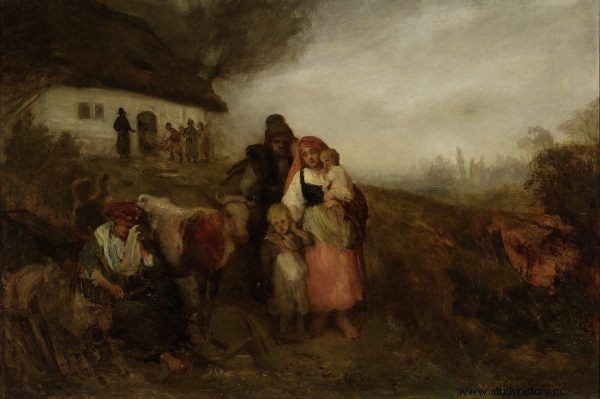
At the turn of the 18th and 19th centuries, peasants lived on the verge of starvation. Those who made it to court as your personal servants won the lottery ticket. For some, however, it was not enough. In the illustration the painting by Aleksander Kotsis "Without a Roof".
In the other corner of the room and in a room separated from the bedroom by a thin wall, the bodies of five women were found. The companion of the heiress, the embroiderer, the wardrobe and the servant were killed in a similar way as the owners of the estate . However, one more victim, Mrs. Wyleżyńska's maid, did not have a massacred head. There was a blue streak on her neck from suffocation.
Sealed barrels
The Civil-Military Commission from Warsaw brought to Niewirków was responsible for the explanation of the mass murder. The following discoveries were made during the investigation of the crime scene. Ignacy Wyleżyński, captain of the national cavalry, was a lover of weapons. Court residents testified that he always had a pair of loaded pistols within easy reach. The investigative committee found them on the floor near the bed.
Probably Wyleżyński's first action after finding out that uninvited guests had entered the bedroom was to grab the guns from the table by the bed and aim them at the attackers. Only he couldn't fire a single shot. The barrels - as stated - were sealed with wax.
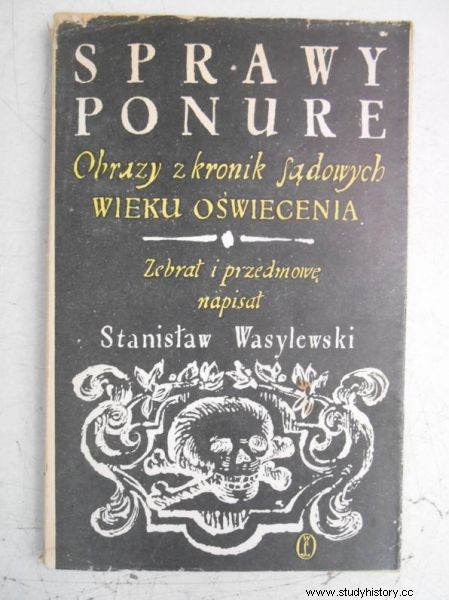
The inspiration for writing the article was, among others, a book by the Polish journalist and author of the diary studies, Stanisław Wasylewski, entitled "Sprawy glorious. Images from the Judicial Chronicles of the Age of Enlightenment.
It was not hard to guess that this was done to prevent the heir from defending himself. The conclusion was that the perpetrators had planned the murder and had preceded it with thorough preparations. Even more intriguing was the fingerprint next to the corpse. Contrary to what was initially thought - it was not chopped off from the heir. The fragment found did not match the stump. It must therefore belong to the perpetrator. Interrogations of the officials and all the servants began, closely examining their hands.
The man from the court did not have a piece of a finger. Although he pleaded guilty to his innocence, he was imprisoned on suspicion of the murders of seven people. The second perpetrator turned out to be a young butler. Only he, the trusted heir, could, in his absence, enter the state bedroom without arousing any suspicions and apply wax to the pistols. It turned out that the murderers had an accomplice. It was Mrs. Wyleżyńska's dead maid, the only one who had been strangled.
Show mercy
If the butler had not confessed to the crime, it would have been hard to believe that he had anything to do with it. He was considered the favorite servant of his master. Ten years ago, the heir, having found in him some unique skills for peasants, took him from the village to the manor and arranged for the education of the fifteen-year-old. The boy took lessons in Polish and German, and learned drawing and playing the violin. After a few years, he became Wyleżyński's personal butler.
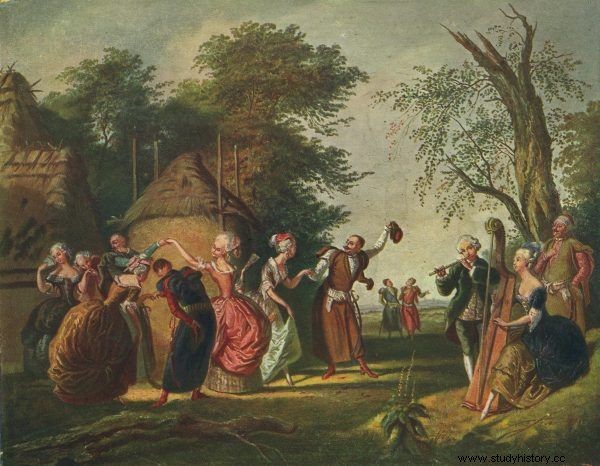
While the Polish nobility partyed, the peasants worked hard - either doing serfdom or serving their country at the table. In the illustration Kornel Szlegel's painting "Polonaise in the open air".
Probably for his parents such a job was an exceptional distinction and meant a better fate of a peasant son. What she was for himself is unknown. In any event, he tried to do his duty diligently. The Wyleżyński family appreciated his work and loyalty, fairly paid him a year's salary and praised him.
But he saw your hypocrisy in all this. Yes, they were kind and generous to him, but only for show. Wyleżyński showed him sympathy and kindness when he was in a good mood or when he wanted to be considered a progressive and democrat. At other times he made it clear that the butler was nothing to him.
Quite recently, the butler turned 25 and decided to get married. His fiancée served as a maid for Mrs. Wyleżyńska. After the wedding, they planned to leave the court and start living together in a different place. In 18th-century Poland (and in the areas that used to be part of the Polish-Lithuanian Commonwealth), serfdom was in force. The fate of a peasant was entirely decided by his master. Without permission, it was impossible to dismiss or get married .
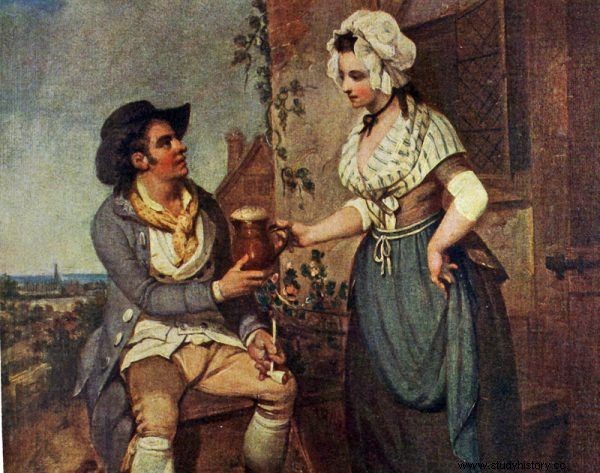
The domestic servants also had the right to love ... But this was forgotten by the Wyleżyński family, who were brutally murdered for refusing to consent to the marriage of their subjects.
Unfortunately, the Wyleżyński family refused the young people's request without giving any reason. In addition, they threatened to suffer severe consequences if they did not give up their "ridiculous" plans and ordered them to go away.
Delivery of justice or simple revenge?
For a peasant son who wanted to start a family and possibly return to farming again, it was like the end of the world. Planned revenge. He initiated the criminal plan with a groom, with whom he had been friends for years. Wyleżyński generously rewarded him for his work, but - in his opinion - the mere submission and the inability to decide about his own fate deserved "justice". A maid was also dragged into the plot, but the plans for the murder were not revealed. As they cleverly put it - the gentlemen deserved a "lesson".
On March 30, 1789, Holy Week began. When the Wyleżyński family went to the church at noon for the service, the butler entered the state's bedroom. He secretly let the groom in, and together they glued wax to the guns that the heir had put at the headboard during the night. Additionally, they tied the saber with a string so that it could not be pulled out of the scabbard. The first part of the plan has been completed.

As a result of the partitions, the eastern territories of the Polish-Lithuanian Commonwealth found themselves within the borders of the Russian Empire. Including Volhynia, where the crime described in the article took place. The illustration shows the map of the Volyn Governorate.
A few hours later, the maid, leaving the state bedroom after the end of her service, left - as they had agreed - the door open. The real shambles began a few minutes later. The peasants first killed a girl who, seeing them with axes, guessed the true intentions of her fiancé and his friend . She wanted to sound the alarm, but the groom put his hand over her mouth and then strangled her with a rope.
Surprised by the night attack, the Wyleżyński family tried to face the murderers. The heir, finding that the guns were useless, attacked the groom with his bare hands. In a scuffle, he bit off a piece of his finger, and the other "repaid" him the same. The peasant, however, quickly deprived his master of his life with a strong blow from an ax. During this time, the butler dealt with Mrs. Wyleżyńska.
The other women, visiting the Wyleżyński family, were so terrified that they made no attempts to defend themselves. They only begged the attackers to spare, which did not bring the slightest effect. After getting rid of all the people present in both rooms, the murderers stole money and valuables belonging to the heirs. Two other palace butlers slept soundly at that time, and that was no accident. That day, the butler generously welcomed them to the inn with booze.
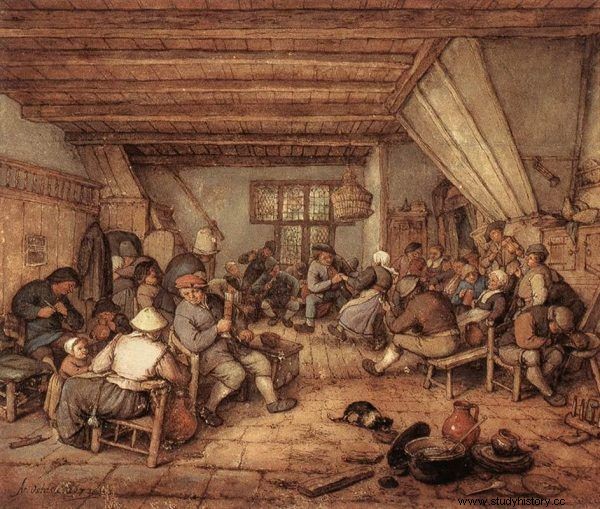
Peasant drunkenness has almost become legendary today. So what was the best way to get rid of uncomfortable witnesses? It was enough to give them booze. In the illustration the painting by Adriaen van Ostade "Peasants feasting in a tavern".
The perpetrators were severely punished by the court. It didn't matter if one of them was guilty and repented. The executioner first burned their hands to the elbows, then chopped off their heads and limbs, which were nailed to the gallows and placed on public roads as a warning .
The murder of seven people made a shocking impression on the whole of Volhynia. There were voices that Wyleżyński himself indirectly led to the tragedy. He did the wrong thing, awakening the ambitions of the servants, and then pouring cold water on the "little ones", showing them a place in the line.
But what about the murderers themselves? The originator of revenge did not spare even his beloved. Just as no one could be safe when the Peasant Revolution really took place some 50 years later. And the leader was Jakub Szela, who was driven not only by the will to take revenge for the plight of the peasants, but also by his personal ambition.
